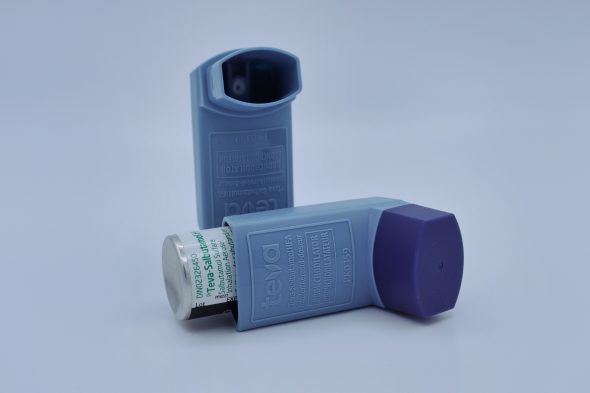Strategy for inhaled corticosteroid use leads to better asthma outcomes, according to national study of Black and Latinx patients

A national study has found that when patients who self-identified as Black or Latinx were instructed to use inhaled corticosteroids when they needed reliever medication for asthma, their risk of severe exacerbation was reduced by 15% and they missed fewer days of normal activity when compared with those who were instructed to use only a fast-acting medication for asthma symptoms.
The study included 1,200 Black and Latinx adults with moderate or severe asthma who were followed for 15 months by researchers across the U.S. and Puerto Rico, including asthma experts at the University of Illinois Chicago.
The UIC team followed 60 patients with asthma who enrolled in the study, which was conducted from November 2017 to April 2021.
Historically, asthma patients have been instructed to use a daily controller medication — which includes an inhaled corticosteroid — to prevent asthma symptoms and a fast-acting medication like an albuterol inhaler or nebulizer to relieve symptoms. While guidelines have been modified to reflect modern research evidence that says instructing patients to use both medications during symptoms is beneficial, most of this evidence comes from studies that were not designed to mimic the real world. For example, patients may have been excluded if their asthma was severe, if they used a nebulizer or if they had other medical conditions. Most studies also were not designed to focus on populations that face a disproportionate burden of complications from asthma, like Black and Latinx populations that are underrepresented in research.
“We know that new patient-centered strategies to use controller medications with relievers when symptoms occur work in clinical trials and guidelines are finally changing to reflect this,” said study co-author Paul Stranges, clinical assistant professor at the UIC College of Pharmacy. “What we still needed to see is if these approaches work outside controlled clinical trials and if they work for all people with asthma, especially those in high-risk communities.”
Black and Latinx individuals experience higher rates of asthma-related emergency department visits, higher rates of hospitalizations and approximately double the asthma mortality rate compared with white individuals, but interventions to reduce this disparity have so far had varied results.
Data from the national study, which was led by investigators from Brigham and Women’s Hospital, is reported in the New England Journal of Medicine.
Participants in the study, which is called PREPARE (PeRson EmPowered Asthma RElief), were randomized into two groups and completed questionnaires. More than 70% of participants reported at least one asthma exacerbation in the previous year, and 67% reported using a nebulizer for quick-reliever treatment.
There was only one in-person visit during the study and at that visit participants received instructions and watched a video appropriate to their arm of randomization. The intervention group received one-time instruction to use an inhaled corticosteroid when they used an asthma reliever or nebulizer in addition to whatever medications they were taking for asthma. The control group received one-time instruction to continue their usual care. All materials were also available in Spanish.
At the end of the study, participants in the intervention group had an annualized rate of severe asthma exacerbations that was lower than the rate for the control group (0.69 vs. 0.82 per patient), a 15% risk reduction. Participants in the intervention group also had improved scores for asthma control and symptoms, and they missed fewer days of their usual activities, like school or work (13.4 vs. 16.8 days). Participants in the intervention group used about one extra canister of controller medication a year, but their overall exposure to corticosteroids is calculated to be reduced overall due to reduced hospital visits.
“In addition to the positive clinical results, we also saw a high level of engagement among participants in the study, which suggests that this intervention is appealing to individuals,” Stranges said.
“Results of the PREPARE trial show us that we can help reduce the impact of asthma through the simple, patient-centered intervention of having patients use ICS whenever they use their rescue inhaler or nebulizer to treat symptoms. This intervention is effective — easy to implement, easy to use and comes at a low cost,” said study leader Dr. Elliot Israel of Brigham and Women’s Hospital in a news release on the findings.
Additional co-authors of the New England Journal of Medicine study, “Reliever-Triggered Inhaled Glucocorticoid in Black and Latinx Adults with Asthma,” include researchers from the University of South Florida, Tampa; University of Miami; University of Florida; University of Central Florida; University of Colorado, Aurora; Duke University; University of Alabama, Birmingham; Johns Hopkins; Albert Einstein College of Medicine; Case Western Reserve University; University of Puerto Rico, San Juan; University of North Carolina; University of Pennsylvania; Temple University; Yale; and the University of Southern California, Los Angeles.
The research was funded by grants from the Patient-Centered Outcomes Research Institute (PCS-1504-30283), the National Institute of Allergy and Infectious Diseases (K23AI125785), and the American Lung Association American Academy of Allergy, Asthma, and Immunology (AI-835475). The extra inhaled corticosteroid and pharmacy services were provided by Teva Pharmaceuticals. Exhaled nitric oxide meters were provided by Circassia Pharmaceuticals Inc.
